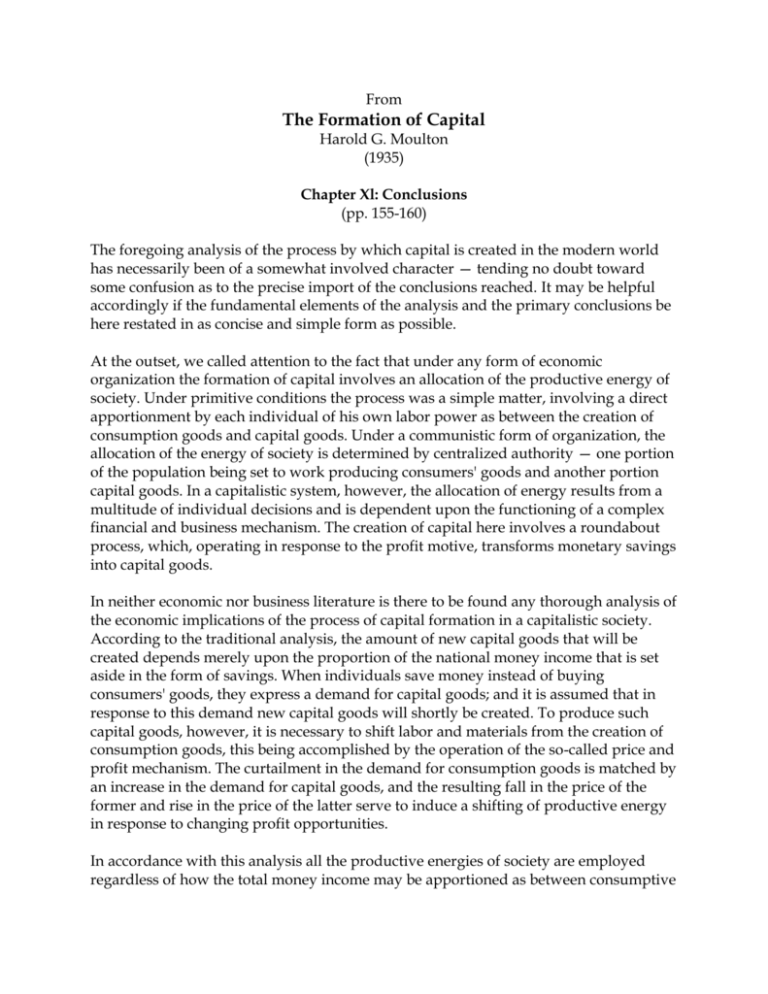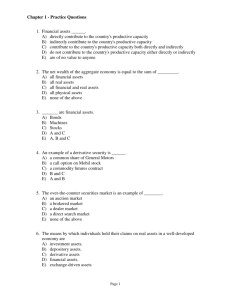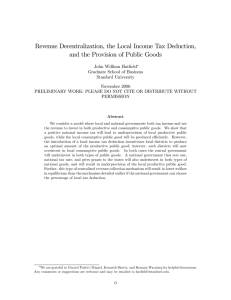From The Formation of Capital Harold G. Moulton (1935) Chapter Xl
advertisement

From The Formation of Capital Harold G. Moulton (1935) Chapter Xl: Conclusions (pp. 155-160) The foregoing analysis of the process by which capital is created in the modern world has necessarily been of a somewhat involved character — tending no doubt toward some confusion as to the precise import of the conclusions reached. It may be helpful accordingly if the fundamental elements of the analysis and the primary conclusions be here restated in as concise and simple form as possible. At the outset, we called attention to the fact that under any form of economic organization the formation of capital involves an allocation of the productive energy of society. Under primitive conditions the process was a simple matter, involving a direct apportionment by each individual of his own labor power as between the creation of consumption goods and capital goods. Under a communistic form of organization, the allocation of the energy of society is determined by centralized authority — one portion of the population being set to work producing consumers' goods and another portion capital goods. In a capitalistic system, however, the allocation of energy results from a multitude of individual decisions and is dependent upon the functioning of a complex financial and business mechanism. The creation of capital here involves a roundabout process, which, operating in response to the profit motive, transforms monetary savings into capital goods. In neither economic nor business literature is there to be found any thorough analysis of the economic implications of the process of capital formation in a capitalistic society. According to the traditional analysis, the amount of new capital goods that will be created depends merely upon the proportion of the national money income that is set aside in the form of savings. When individuals save money instead of buying consumers' goods, they express a demand for capital goods; and it is assumed that in response to this demand new capital goods will shortly be created. To produce such capital goods, however, it is necessary to shift labor and materials from the creation of consumption goods, this being accomplished by the operation of the so-called price and profit mechanism. The curtailment in the demand for consumption goods is matched by an increase in the demand for capital goods, and the resulting fall in the price of the former and rise in the price of the latter serve to induce a shifting of productive energy in response to changing profit opportunities. In accordance with this analysis all the productive energies of society are employed regardless of how the total money income may be apportioned as between consumptive expenditures and savings for investment. Since all monetary savings are assumed to be transformed automatically into capital equipment, it follows that the greater the proportion of the national income that is saved, the greater the growth of capital and the more rapid the rate of economic progress. Our analysis of the process of capital formation may be summarized as follows. To begin with, we challenged the assumption that money savings enter the market as direct demand for capital goods. We contended that such savings merely constitute a supply of money available to business enterprisers for use in the construction of new plant and equipment. Whether it will be profitable to use such funds in the formation of new capital depends upon the possibility of selling the commodities which such capital can produce. The demand for capital goods is derived from the demand for consumption goods. Hence, an increase in savings at the expense of consumptive demand will decrease rather than increase the output of capital goods. In the light of this general analysis we reached a preliminary conclusion that if new capital is to be created there must be an increasing flow of funds through consumption channels as well as through savings channels. We then turned to a study of the evidence afforded by our industrial history as to the conditions under which a growth of capital does in fact take place. The evidence led us to the following conclusions. 1. The facts show incontrovertibly that new capital is constructed on an extensive scale when consumption is expanding rather than when it is contracting. The bulk of our capital is created in periods of general economic expansion, when productive resources are being more fully utilized than at other times. The process does not involve an extensive shifting of labor and materials from consumption goods industries to the formation of capital. Nor do the prices of consumption goods and capital goods tend to move in opposite directions. 2. The evidence indicates that in a period when the output of both consumption and capital goods is being increased, there is an expanding flow of funds through both consumption and investment channels. This simultaneous increase is made possible by the expansive quality of our commercial banking credit system. 3. The available evidence also supports the view that the growth of capital is directly related to the demand for consumption goods. In the first place, changes in the direction of business activity in most cases appear to have begun with factors affecting the consumption side of the economic picture. In the second place, the growth of new capital is adjusted to the rate of expansion of consumptive demand rather than to the volume of savings available for investment. Between 1923 and 1929, for example, the volume of securities floated for purposes of constructing plant and equipment remained practically unchanging in amount from year to year, despite the fact that the volume of money available for investment purposes was increasing rapidly. Regardless of the amount of money available for the construction of new plant and equipment, the growth of capital goods was adjusted to the rate at which consumptive demand was increasing. Although the traditional analysis recognized that new capital is created with a view to a subsequent expansion in the output of consumption goods, it was assumed that business enterprisers would proceed for years to create new capital, thereby extending the "roundabout processes of production," even though consumptive demand might for the time be declining, or lagging. The facts which we have assembled afford no support for this assumption. The conclusions which we have reached with reference to the dependence of the growth of capital upon the concurrent expansion of consumptive demand have an important bearing upon the relationship of the distribution of the national income to economic progress. If, in consequence of wide variations in the distribution of income, the proportion of the national income that is saved expands rapidly, there results a maladjustment which retards rather than promotes the expansion of capital. The rapid growth of savings as compared with consumption in the decade of the twenties resulted in a supply of investment money quite out of proportion to the volume of securities being floated for purposes of expanding plant and equipment, while at the same time the flow of funds through consumptive channels was inadequate to absorb — at the prices at which goods were offered for sale — the potential output of our existing productive capacity. The excess savings which entered the investment market served to inflate the prices of securities and to produce financial instability. A larger relative flow of funds through consumptive channels would have led not only to a larger utilization of existing productive capacity, but also to a more rapid growth of plant and equipment. The phenomenon of an excessive supply of funds in the investment markets had never been anticipated. Not only had it been assumed that all savings would automatically be transformed into capital equipment, but it seemed impossible to conceive of a situation in which savings might become redundant. Such a point of view is natural enough in the light of our historical evolution. In the early history of this country the volume of funds available for the purposes of capitalistic enterprise was persistently inadequate. Business men often found it difficult to obtain the liquid capital, at any price, with which to expand the size of their business undertakings or to exploit new fields of enterprise. In colonial days, for example, the shortage of funds was a continual source of difficulty and a primary cause of irritation with the mother country, which opposed the issuance of bills of credit by colonial governments. Until well into the nineteenth century the volume of savings rendered available through investment channels for the needs of business enterprisers was negligible in amount. The philosophy which emphasized the fundamental importance of increased savings was a realistic one for that age. In the period since the Civil War, however, two factors have combined to produce a profound change in this situation. The first has been the growth of a well-to-do middle class, with funds available for investment. The second has been the development of the commercial banking system, making possible an expansion of credit to business enterprise for both fixed and working capital purposes. It is these developments which account for the emergence of the United States as a great financial power. Not only do we now have an abundance of funds with which to finance American enterprise, but we are also able to extend credits to the world at large. In this development we have followed the road which England traveled at an earlier date. At the present stage in the economic evolution of the United States, the problem of balance between consumption and saving is thus essentially different from what it was in earlier times. Instead of a scarcity of funds for the needs of business enterprise, there tends to be an excessive supply of available investment money, which is productive not of new capital goods but of financial maladjustments. The primary need at this stage in our economic history is a larger flow of funds through consumptive channels rather than more abundant savings. The Diagnosis of Major C. H. Douglas (From Appendix A: “Other Analyses of Savings Process,” pp. 179-181) No little publicity has been given to an analysis of the sources of economic difficulty by Major C. H. Douglas of the British Royal Air Force.1 Major Douglas finds the roots of the economic disease in the discrepancy between payments for wages, salaries, and dividends, and the prices of products. He argues that since the aggregate price of all goods offered for sale greatly exceeds the aggregate disbursements to consumers, depression is inescapable unless bank credit is issued to individuals in sufficient amounts to make up the deficiency in purchasing power. Douglas arrives at the conclusion that the money income available for the purchase of commodities is deficient by a process which eliminates from the picture a large part of the national income. He contends that the price of a given commodity must cover "(A) all payments made to individuals ( wages, salaries, and dividends); (B) all payments made to other organizations (raw materials, bank charges, and other external costs )." Now the rate of flow of purchasing power to individuals is represented by A, but since all payments go into prices, the rate of flow of prices cannot be less than A + B. The 1 Credit Power and Democracy, 1920, and The Control and Distribution of Production, 1922. product of any factory may be considered as something which the public ought to be able to buy, although in many cases it is an intermediate product of no use to individuals but only to a subsequent manufacturer; but since A will not purchase A + B, a proportion of the product at least equivalent to B must be distributed by a form of purchasing power which is not comprised in the descriptions grouped under A.2 This means that if the payments made by a given business under A amounted to one dollar and the payments made under B amounted to another dollar, the price of the commodity produced would be two dollars; but there would be only the A dollar available with which to buy it. The fallacy in Major Douglas' analysis is that he concentrates attention upon a single business rather than upon the national economy as a whole. These "external" payments to other organizations do not involve sending the money outside the country, and hence their disbursement is a part of the national income as a whole. That is to say, the payments for raw materials, bank charges, etc., are also disbursed to individuals by raw material producing industries and "other organizations" in the form of wages, salaries, and dividends. Taking the national economy as a whole the aggregate prices of goods and services simply cover the aggregate disbursements of wages, salaries, rents, commissions, and profits to individuals engaged in the processes of production. The analysis which we have made in America's Capacity to Consume, revealing a demand for consumption goods insufficient to call forth the full output of our productive establishment, is not to be regarded as supporting either the position of Major Douglas or of Foster and Catchings. Our analysis did not show that the aggregate disbursements of national income to individuals were less than the aggregate prices of the goods and services turned out; on the contrary, we contended that they were virtually identical. We were concerned with the allocation of the national income as between savings for investment and expenditures for consumptive purposes; and we showed merely that the proportion of the total income received by individuals which found its way into consumptive channels was inadequate to induce full capacity production. 2 Credit Power and Democracy, pp. 21-22.








